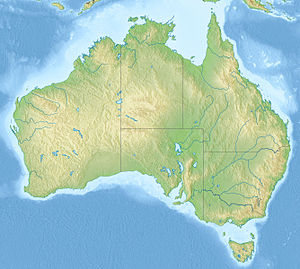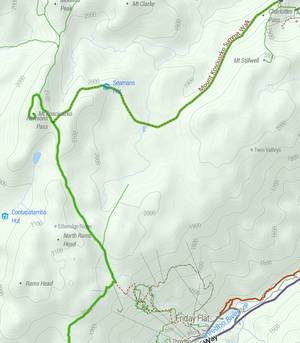Mount Kosciuszko
| Mount Kosciuszko | |
|---|---|
| Jagungal, Jar-gan-gil, Tar-gan-gil, Tackingal[1] | |

Mount Kosciuszko summit.
|
|
| Highest point | |
| Elevation | 2,228 m (7,310 ft) [2][3] |
| Prominence | 2,228 m (7,310 ft) [2] |
| Isolation | 1,894.26 km (1,177.04 mi) [2] |
| Listing | |
| Coordinates | 36°27′27″S 148°15′44″E / 36.45750°S 148.26222°ECoordinates: 36°27′27″S 148°15′44″E / 36.45750°S 148.26222°E [4] |
| Geography | |
|
|
|
| Parent range | Main Range, Great Dividing Range |
| Topo map | Perisher Valley |
| Climbing | |
| First ascent |
1840 by Paweł Edmund Strzelecki (European)[2][4] Ancient Times by Indigenous Australians |
| Easiest route | Walk (dirt road) |
Mount Kosciuszko is a mountain located on the Main Range of the Snowy Mountains in Kosciuszko National Park, part of the Australian Alps National Parks and Reserves, in New South Wales, Australia and is located west of Crackenback and close to Jindabyne.
With a height of 2,228 metres (7,310 ft) above sea level, it is the highest mountain in Australia.[2][3] Various measurements of the peak originally called Kosciuszko showed it to be slightly lower than its neighbour, Mount Townsend. The names of the mountains were swapped by the New South Wales Lands Department in 1892 so that Mount Kosciuszko remains the name of the highest peak of Australia, and Mount Townsend ranks as second.[5] The 1863 picture by Eugene von Guerard hanging in the National Gallery of Australia titled "Northeast view from the northern top of Mount Kosciusko" is actually from Mount Townsend.[6][7][8]
Contents
Etymology[edit]
It was named by the Polish explorer Pawel Edmund Strzelecki in 1840, in honour of the Polish-Lithuanian national hero, General Tadeusz Kościuszko,[note 1] because of its perceived resemblance to the Kościuszko Mound in Kraków.[9]
The name of the mountain was previously spelt "Mount Kosciusko", an Anglicisation, but the spelling "Mount Kosciuszko" was officially adopted in 1997 by the Geographical Names Board of New South Wales.[4] The traditional English pronunciation of Kosciuszko is /kɒziːˈʌskoʊ/, but the pronunciation /kɒˈʃʊʃkoʊ/ is now sometimes used,[10] which is substantially closer to the Polish pronunciation [kɔɕˈt͡ɕuʂkɔ] (![]() listen).
listen).
There are several native Aboriginal (Ngarigo) names associated with the mountain, with some confusion as to the exact sounds. These are Jagungal, Jar-gan-gil, Tar-gan-gil, Tackingal; however, all of them mean "Table Top Mountain."[1]
Formation[edit]
The mountain was formed, by geologic uplift.[11] It was not formed by any recent volcanic activity.[12] Eroded granite intrusions remain at the summit as large boulders above the more heavily eroded sedimentary rocks.[12]
Reaching the summit[edit]
Mount Kosciuszko is the highest summit in mainland Australia. Until 1977 it was possible to drive from Charlotte Pass to within a few metres of the summit, but in 1977 the road was closed to public motor vehicle access due to environmental concerns. The road is open from Charlotte Pass for walkers and cyclists for 7.6 kilometres (5 mi)[13] to Rawson Pass, at an elevation of 2,100 metres (6,900 ft) above sea level. From there a 1.4-kilometre (1 mi) walking path leads to the summit. Cyclists must leave their bicycles at a bicycle rack at Rawson Pass and continue to the summit on foot. Anyone with a modest level of fitness can walk to the top.
The peak may also be approached from Thredbo, taking 3 to 3.5 hours for a round trip. This straightforward walk starts from the top of the Thredbo Kosciuszko Express chairlift, which operates all-year round. The walking path is popular in summer, and is a mesh walkway to protect the native vegetation and prevent erosion. It is 5 kilometres (3.1 mi) to Rawson Pass, where it meets the track from Charlotte Pass, and from where it is a further 1.4 kilometres (0.87 mi) to the summit. The walk to the summit is the easiest of all the Seven Summits.[14]
Australia's highest public toilet was built at this pass in 2007, to cope with the more than 100,000 people visiting the mountain each summer.[15]
The peak and the surrounding areas are snow-covered in winter and spring (usually beginning in June and continuing until October or later). The road from Charlotte Pass is marked by snow poles and provides a guide for cross-country skiers and the track from Thredbo is easily followed until covered by snow in winter.
|
||||||||||||||
Recreation[edit]
Kosciuszko National Park is also the location of the downhill ski slopes closest to Canberra and Sydney, containing the Thredbo, Charlotte Pass, and Perisher ski resorts. Mount Kosciuszko may have been ascended by Indigenous Australians long before the first recorded ascent by Europeans.
Each year in December, an ultramarathon running race called the Coast to Kosciuszko ascends to the top of Mount Kosciuszko after starting at the coast 240 kilometres (150 mi) away. Paul Every, who is credited as being the one who thought of holding such a race, was the inaugural co-winner in 2004.[16]
Higher Australian mountains[edit]
Higher peaks exist within territory administered or claimed by Australia, but outside the continent are Mawson Peak (2,745 m or 9,006 ft) on Heard Island and Dome Argus (4,030 m or 13,220 ft), Mount McClintock (3,490 m or 11,450 ft) and Mount Menzies (3,355 m or 11,007 ft) in the Australian Antarctic Territory.
Higher peaks in the region, but outside the mainland continent include:
- Puncak Jaya (4,884 m or 16,024 ft) in New Guinea. It is the highest island mountain in the world, the highest mountain in Indonesia and the highest in the Australian continent and Oceania
- Puncak Mandala (4,760 m or 15,620 ft) in the Papua province of Indonesia. It is the second highest mountain of the Australian continent, Oceania, Australasia, New Guinea and Indonesia
- Puncak Trikora (4,750 m or 15,580 ft) in the Papua province of Indonesia.
- Mount Wilhelm (4,509 m or 14,793 ft) in Papua New Guinea. It is the highest mountain in that country.
- Mount Victoria (4,072 m or 13,360 ft) in Central Province, Papua New Guinea.
- Mount Giluwe (4,368 m or 14,331 ft) a volcanic mountain in Papua New Guinea. It is the highest volcanic summit in the Australian continent.
In popular culture[edit]
Australian rock band Midnight Oil performed a song called "Kosciusko" on its 1984 album Red Sails in the Sunset, referring to the mountain. The spelling was updated to "Kosciuszko" for the group's 1997 compilation album, 20,000 Watt R.S.L.
Gallery[edit]
-
Lake Cootapatamba, the lake on the highest place in the Australian continent
-
Thredbo from the Australian Alps Walking Track
See also[edit]
Notes[edit]
- ^ Kościuszko was also a national hero in Lithuania, and Belarus, and hero of the American Revolutionary War
References[edit]
- ^ a b "James M. Spencer, The Highest Point in Australia". The Sydney Morning Herald. National Library of Australia. 18 February 1885. p. 7. Retrieved 22 February 2014.; cited in Alan E.J. Andrews, Kosciusko: The Mountain in History, O'Connor, A.C.T, Tabletop Press, 1991, p. 50.
- ^ a b c d e "Mount Kosciuszko, Australia". Peakbagger.com. Retrieved 28 May 2015.
- ^ a b "Kosciuszko National Park". Australian Alps National Parks. Australian Government. Retrieved 13 June 2009.
- ^ a b c "Mount Kosciuszko". Geographical Names Register (GNR) of NSW. Geographical Names Board of New South Wales. Retrieved 27 May 2015.
- ^ "Mountain systems of Australia". Year Book Australia, 1901-1909. Australian Bureau of Statistics.
- ^ "Eugene von Guérard: North-east view from the northern top of Mount Kosciusko 1863". National Gallery of Australia. Archived from the original on 4 November 2008.
- ^ http://www.jokar.com.au/projects/Ten-Mile%20Stare/slides/Mt_Townsend_Panorama1.html
- ^ Webpage of proper name explanations
- ^ "Australian Geographical Name Derivations". Wikiski.com. 8 April 2011. Retrieved 18 June 2012.
- ^ Yallop, Colin, ed. (2005). Macquarie Dictionary (4th ed.). Melbourne: The Macquarie Library. ISBN 1-876429-14-3.
- ^ Geology Page: Geologists discover how Australia's highest mountain was created | Geology Page, accessdate: February 17, 2017
- ^ a b Erfurt-Cooper, Patricia (2014). Volcanic Tourist Destinations. Springer Science & Business Media. p. 273. ISBN 9783642161919. Retrieved 24 April 2017.
- ^ National Parks' 'Southern Kosciuszko walking tracks factsheet'
- ^ Hamill, Mike (2014). Climbing the Seven Summits: A Comprehensive Guide to the Continents' Highest Peaks. The Mountaineers Books. p. 275. ISBN 9781594856495. Retrieved 24 April 2017.
- ^ "The rush to complete Australia's highest dunny" (PDF). Department of Environment and Climate Change, NSW. 3 May 2007. pp. 6–7.
- ^ "Coast to Kosciuszko". Coast2kosci.com. Retrieved 18 June 2012.
External links[edit]
| Wikisource has the text of the 1911 Encyclopædia Britannica article Kosciusco. |
| Wikimedia Commons has media related to Mount Kosciuszko. |
- Mt Kosciuszko Inc. — page for information about explorer P.E. Strzelecki – and news about Mount Kosciuszko
- Peakware – World Mountain Encyclopaedia — photo














